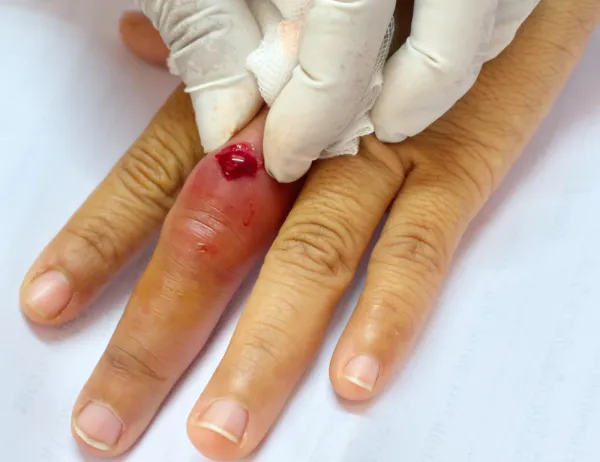Follow 3 Steps Seize the Right Code for Pilonidal Cyst I&D
Scan through the provider’s detail to spot on the right set of codes!
When your physician performs incision and drainage (I&D) of a pilonidal cyst or sinus, remember you have a separate code set for the procedure. Pay attention to your provider’s details to identify the difference between simple and complicated I&D, and you’ll be on your way to a successful claim.
Step 1: Start With the Correct Code Set
A pilonidal cyst or sinus is entrapped epithelial tissue located in the sacrococcygeal region above the buttocks. These lesions are usually associated with ingrown hair. A sinus cavity is present and may have a fluid-producing cystic lining.
While you will report most of your physician’s I&D procedures with 10060 (Incision and drainage of abscess [e.g., carbuncle, suppurative hidradenitis, cutaneous or subcutaneous abscess, cyst, furuncle, or paronychia]; simple or single) or 10061 (…complicated or multiple), you turn to different codes when reporting an I&D of a pilonidal cyst.
If the documentation specifically states “pilonidal cyst,” or provides a detailed location for you to clearly make that conclusion, you can report I&D with 10080 (Incision and drainage of pilonidal cyst; simple) or 10081 (Incision and drainage of pilonidal cyst; complicated).
Take note: Different codes apply when the physician performs an excision along with the I&D.
Diagnosis: ICD-10 has two codes that apply to pilonidal cysts: L05.91 (Pilonidal cyst without abscess) and L05.92 (Pilonidal sinus without abscess). For a pilonidal cyst or sinus with abscess, report L05.01 or L05.02, respectively. The physician’s documentation in the example scenario does not mention an abscess; therefore, you need to report L05.92.
Step 2: Distinguish Between Simple and Complicated I&D
To prevent unnecessary loss of deserved pay, you will need to be able to identify when to report a complicated I&D of a pilonidal cyst.
From a CPT® perspective, the classification of “simple” versus “complicated” is at the physician’s discretion, based on the level of difficulty involved in the incision and drainage procedure.
One way to distinguish “simple” from “complicated” in this context is the depth of the cyst and whether or not it has multiple sinus tracts. For instance, you would likely report 10080 when the location of the pilonidal cyst is more superficial or when the lesion is not severely infected or doesn’t have multiple sinus tracts. You may also look at the type of closure that your clinician performed after the procedure. If no closure is done or if a simple closure is performed, you will likely report 10080, which corresponds to a “simple” procedure.
On the other hand, if the documentation reads that the location of the cyst was deeper in the subcutaneous layers or if the lesion was severely infected, you will more likely choose 10081 for the I&D, because the procedure will be more extensive and complicated. You may also want to choose 10081 if your clinician mentions the presence of multiple abscesses or sinus tracts in the documentation. Finally, if your clinician performs a layered closure after the procedure and packs the surgical site with wound packing, you will likely report 10081 instead of 10080.
Clinical scenario: A patient reports to your physician with complaints of pain and tenderness at the apex of his gluteal cleft. He says he began experiencing some pain a few days ago, and the pain has been increasing since then and becomes more pronounced when he tries to sit down. Upon examination, your FP finds a tender, egg-sized mass that has a small opening with a hair at its center. Your clinician then preps the patient, and makes a stab incision to the cyst, which yields 15 ml of pus from the abscess. He then irrigates the cavity, leaves the wound open, and instructs the patient to schedule a follow-up visit.
What to report: Since your physician drained a superficially located, simple pilonidal cyst and did not perform any wound closure, report the procedure with 10080 and diagnosis L05.01.
Step 3: Choose Different Codes for Excision
In some instances, your clinician might perform an I&D of a pilonidal cyst and then determine that an I&D will not help in completely eliminating the problem. So, he then performs an excision of the cyst at the same encounter. In such a case, you have three code choices for reporting the pilonidal cyst excision:
“CPT® also does not define ‘simple,’ ‘extensive,’ or ‘complicated’ in this context, other than to suggest that it is based on the complexity of the erosion,” Kent Moore, senior strategist for physician payment at the American Academy of Family Physicians, observes. “Thus, the choice of code is again left to the physician’s discretion.”
Remember: For a small or simple sinus, the physician uses a scalpel to completely excise the involved tissue. The wound is sutured in a single layer, and the procedure is reported with code 11770. An extensive sinus is superficial to the underlying fascia but has subcutaneous extensions. The physician uses a scalpel to completely excise the lesion.
A clinical scenario: A 58-year-old female with a pilonidal cyst came to your facility for an excision. The area of the pilonidal cyst was identified. The physician used a 10-blade scalpel to make an elliptical incision to excise the area of the pilonidal cyst. This was carried down to just above the rectum and anus, at the sacral level. He removed a large portion of the involved areas, as well as extra (extensive) subcutaneous tissue. Hemostasis was achieved with electrocautery and the area was copiously irrigated with saline. No further disease was noted.
Because this was an extensive excision, you should submit 11771.
Irrespective of the code that you choose for reporting the excision, you will not report the I&D procedure with 10080 or 10081 in addition to the excision.
Rationale: According to CMS guidelines in the Correct Coding Initiative (CCI), “If it is necessary to incise and/or drain a lesion as part of another procedure or in order to gain access to an area for another procedure, the incision and/or drainage is not separately reportable if performed at the same patient encounter. … HCPCS/CPT® codes for incision and drainage should not be reported separately with other procedures such as excision, repair, destruction, removal, etc., when performed at the same anatomic site at the same patient encounter.”
Exception: If your clinician performs I&D of a pilonidal cyst in one anatomic location and excises another pilonidal cyst or sinus tract in a separate anatomic location, you can report both the procedures. Append a modifier (such as 59 [Distinct procedural service] or XS [Separate structure]) to the I&D code to support reporting both procedures.




